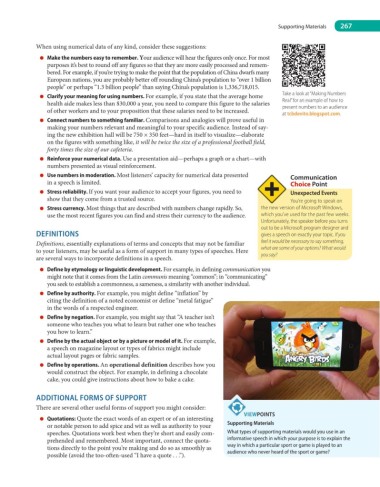Page 288 - Essentials of Human Communication
P. 288
Supporting Materials 267
When using numerical data of any kind, consider these suggestions:
● Make the numbers easy to remember. Your audience will hear the figures only once. For most
purposes it’s best to round off any figures so that they are more easily processed and remem-
bered. For example, if you’re trying to make the point that the population of China dwarfs many
European nations, you are probably better off rounding China’s population to “over 1 billion
people” or perhaps “1.3 billion people” than saying China’s population is 1,336,718,015.
● Clarify your meaning for using numbers. For example, if you state that the average home Take a look at “Making Numbers
health aide makes less than $30,000 a year, you need to compare this figure to the salaries Real” for an example of how to
present numbers to an audience
of other workers and to your proposition that these salaries need to be increased. at tcbdevito.blogspot.com.
● Connect numbers to something familiar. Comparisons and analogies will prove useful in
making your numbers relevant and meaningful to your specific audience. Instead of say-
ing the new exhibition hall will be 750 × 350 feet—hard in itself to visualize—elaborate
on the figures with something like, it will be twice the size of a professional football field,
forty times the size of our cafeteria.
● Reinforce your numerical data. Use a presentation aid—perhaps a graph or a chart—with
numbers presented as visual reinforcement.
● Use numbers in moderation. Most listeners’ capacity for numerical data presented Communication
in a speech is limited. Choice Point
● Stress reliability. If you want your audience to accept your figures, you need to unexpected events
show that they come from a trusted source. You’re going to speak on
● Stress currency. Most things that are described with numbers change rapidly. So, the new version of Microsoft Windows,
use the most recent figures you can find and stress their currency to the audience. which you’ve used for the past few weeks.
Unfortunately, the speaker before you turns
out to be a Microsoft program designer and
defInItIOns gives a speech on exactly your topic. If you
Definitions, essentially explanations of terms and concepts that may not be familiar feel it would be necessary to say something,
to your listeners, may be useful as a form of support in many types of speeches. Here what are some of your options? What would
are several ways to incorporate definitions in a speech. you say?
● Define by etymology or linguistic development. For example, in defining communication you
might note that it comes from the Latin communis meaning “common”; in “communicating”
you seek to establish a commonness, a sameness, a similarity with another individual.
● Define by authority. For example, you might define “inflation” by
citing the definition of a noted economist or define “metal fatigue”
in the words of a respected engineer.
● Define by negation. For example, you might say that “A teacher isn’t
someone who teaches you what to learn but rather one who teaches
you how to learn.”
● Define by the actual object or by a picture or model of it. For example,
a speech on magazine layout or types of fabrics might include
actual layout pages or fabric samples.
● Define by operations. An operational definition describes how you
would construct the object. For example, in defining a chocolate
cake, you could give instructions about how to bake a cake.
addItIOnaL fOrMs Of suppOrt
There are several other useful forms of support you might consider:
ViewpOInts
● Quotations: Quote the exact words of an expert or of an interesting
or notable person to add spice and wit as well as authority to your supporting Materials
speeches. Quotations work best when they’re short and easily com- What types of supporting materials would you use in an
prehended and remembered. Most important, connect the quota- informative speech in which your purpose is to explain the
tions directly to the point you’re making and do so as smoothly as way in which a particular sport or game is played to an
possible (avoid the too-often-used “I have a quote . . .”). audience who never heard of the sport or game?

